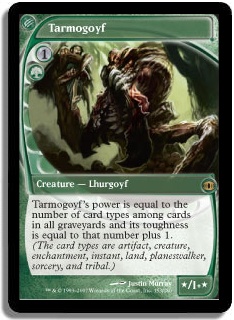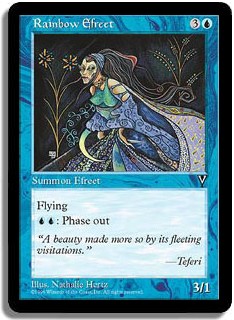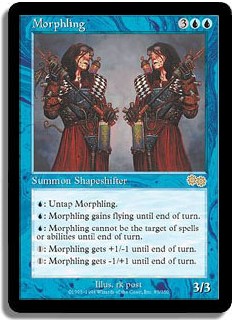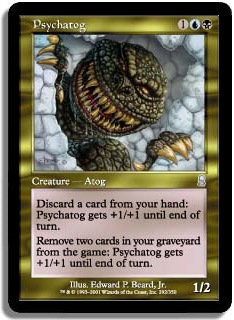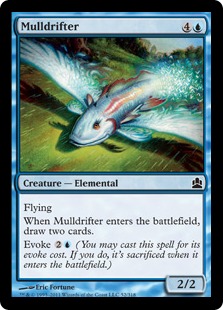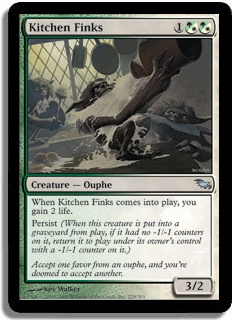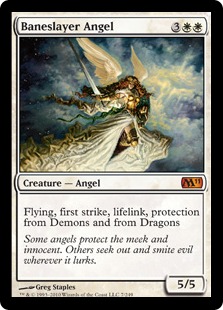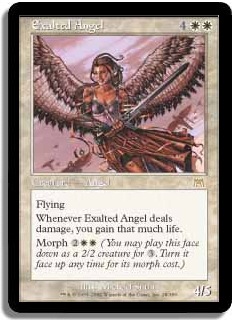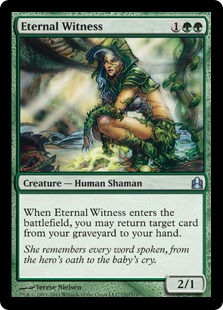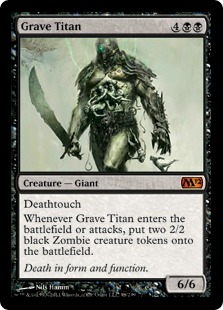Today’s article will be a bit different from the normal deck strategy and Standard discussions you have grown accustomed to from The Icy Grip. Let us take a walk down memory lane as a control player. Since Magic became competitive, control has flourished as an archetype and continuously changes form every few years.
Believe it or not, before planeswalkers, control decks had to deal lethal damage to their opponents by playing a very small, specific number of win conditions that had to be protected in order to achieve victory. This article will break down the 10 best creatures of all time through the eyes of a control mage.
There are at least 50 creatures that came to mind during the brainstorming phase and also a great deal of suggestions through Twitter. I didn’t realize how difficult it could be to decide which ones made the list and which ones did not until I got my trusty notepad and began to list the exceptional pets of control players. I will preface the article by starting with number 11 (honorable mention).
Number 11 — Tarmogoyf
What??!?? Tarmogoyf?? He’s the best creature of ALL TIME.
That reaction is my guess at what many will say when they see the most powerful two-drop landing an honorable mention tag. I and others who play control or a similar archetype understand why he didn’t make top 10.
There are a few rules of thumb that make or break the best creatures of all time in the control archetype. It may be amazing at one, two, or all of the rules that best describe true control creatures.
- It has to do something when it enters the battlefield, leaves the battlefield, or goes to a graveyard. There is a huge reason why the Titans have been all over Standard for quite some time, and that same reason applies to Stoneforge Mystic, which was recently banned for its ability to replace itself at worst on turn 2 and at best put a devastating, uncounterable 4/4 into play the following turn. Tarmogoyf was never banned and never got close to the banning stage. The reason why it’s so fair is because it suffers from one crucial flaw…it’s a creature, and it can be killed easily. What do you get out of it after it has been Smothered? What do you get out of it once it has been stolen from you? Killing a Sun Titan that has returned Jace Beleren to play, or a Yosei that has tapped you down, or a Meloku that has created an instant army tickles a control player’s fancy more than a powerful creature in the early game.
- It has to be tough to kill. Creatures with shroud are the first to come to mind, but the tough-to-kill tag isn’t limited to that. Creatures that are too large or exist in formats with limited removal fall under this category.
- It is a sacrificial lamb whose only purpose is to move the control mage into the late game safely. Creatures that gain life, block, kill things, draw cards, etc. dominate this category. The purpose of playing control is to survive early on and take the game down once the initial waves of threats are dealt with. This category is the most important against aggro decks easily.
- It has to be able to win the game. Creatures with evasion are the first to come to mind, but any creature with special abilities that can end the game also can sneak in here. Although I would love to say control decks are ahead most of the time and can gradually wear an opponent down, sometimes it is necessary to drop a huge threat that can end the game in a few turns.
Although Tarmogoyf is amazing in its power/toughness to mana cost ratio, I believe it fails to breach into the top 10 favorites of a control player. I played Goyf when it was Standard legal and Top 8ed Nationals with that list; however my deck was a ramp deck—not my usual control choice.
The true control decks of the time that used Mystical Teachings or the five-color mana base also avoided Goyf for the most part and chose cards like Mulldrifter; Teferi, Mage of Zhalfir; Shriekmaw; and others as ways to defeat their opponent. Tarmogoyf, like Arcbound Ravager and Goblin Guide, created a hype to play aggressive decks. This hype is justified because all those creatures are amazing and help to develop the best aggro decks of their respective eras. Because of them, we have been able to always develop a counterattack in the form of a control deck that can easily come out ahead in the long run. In closing, regarding Tarmogoyf, I would like to state that he is an amazing card, but I have always preferred to play against him rather than with him.
Number 10 — Rainbow Efreet
One of the original control creatures in the flesh! Those who played Magic back then know the power level of this card, as one of the original creatures to be able to escape removal of any kind. Having only one toughness did not come into play for the most part, and the ability to stack damage and then remove the Efreet from combat was overpowered then, to say the least. Flying was the next best thing on this card to ensure damage would land without opposition from the creatures staring up at it from the ground. The big thing to realize in Magic is that cards keep getting more and more powerful, so a card like this would be an uncommon and unplayable now. Rainbow Efreet during his time was the bee’s knees as a win condition and defensive creature at a reasonable mana cost.
Number 9 — Morphling
Superman! Obviously one of the most flavorful cards of all time, Morphling stands tall, making the top 10 list of best creatures for control players. Each of his abilities was amazing in the long control games.
This creature also took a hit in cubes all over the world when Wizards took damage stacking out of the game, and I am glad that Morphling wasn’t around to see that happen. When you could stack damage and had a great deal of mana, no creature could withstand the five damage to the jugular. With lethal damage stacked, Morphling could then become tougher and escape from the combat step alive.
The ability to avoid all removal for one blue was probably the best reason for running him as the only win condition. Its ability to fly added to the allure of Morphling and earned him his nickname of Superman.
Back in the day, cards in Standard didn’t go for a million dollars like they do now, but this card has always had a decently high price tag for important reasons. Morphling is one of the rare creatures where 3 of the 4 rules apply. It would be hard to find an old school Magic player who did not have fond memories of the best blue creature that has ever lived.
Number 8 — Psychatog
Upheaval floating three…you know what’s coming. This little guy was not so little in reality. His power and toughness fool you when he is dropped in the late game, and he ends the game immediately when he hits you. Sideboards at the time contained ways to give Psychatog shadow and murder you in one hit. When Tog was in Standard, Upheaval left you with exactly one turn to answer the creature—which of course never happened.
Tog almost feels like a combo card except I have had great success with him in U/B Control decks of the past, as I’m sure others have. There was a time in Extended where the power level of Tog was through the roof with Life from the Loam. Gush as well as Fact or Fiction were also good friends with the 1/2 that enabled him to become so much more. In today’s world, Tog is beyond unplayable, but in the past, he was the most feared creature of his time. Tog also was the control player’s default weapon of choice.
Number 7 — Meloku the Clouded Mirror
Meloku has to be my favorite creature of all time. His great ability is his exit strategy of cluttering up the battlefield with 1/1 fliers as he falls to the graveyard. During the Standard format of Meloku, the world wasn’t safe for creatures. Against a slew of removal spells, how could this creature survive? Well he didn’t have to. He truly was a one-man army and always found a spot in each of my decks during his time. Against aggro, he is able to singlehandedly fight off an army of small attackers. Against control, he is able to create a huge force that can only be answered by a board sweep. Creatures like Meloku are very rare, and I hope Wizards can find a spot in a future format to include someone just like him again…and I’m not talking about Emeria Angel.
Number 6 – Mulldrifter
Card advantage and card draw are the most important aspects of a control deck. If you constantly one-for-one your aggro or combo opponents, eventually you will be overrun or overwhelmed. At some point, you need to draw more cards than your opponent or have your spells gain more advantage than what they cost. Mulldrifter is a great example of such a card; it can put two more in your hand as well as attack/block throughout the match. I’ve seen all kinds of decks use and abuse cards such as Mulldrifter with graveyard recursion and Reveillark.
At first glance, someone might question the decision to put this creature in the top 10, but those who have used and interacted with this card understand the power of card draw built into a dude. Mulldrifter beat a few of my buddies that could have made this list, such as Solemn Simulacrum, Wall of Omens, Sea Gate Oracle, and Court Hussar. The point of this list is to look back to the past and take a look at what made some creatures great, and though Mulldrifter isn’t flashy, it always got the job done. [Indeedy I do. —LL]
Number 5 — Kitchen Finks
Kitchen Finks was a four-of in each of the control decks and half of the aggro decks of the past. People weren’t offended when a Bloodbraid Elf cascaded into our Finks friend, and control players were always happy with the three-drop. For the 5CC players, Kitchen Finks was their lifeline for surviving against early aggression. Finks was a proven strategy against all aggro decks and did just fine against control and combo. Three mana for three power wasn’t too shabby—not to mention it came back from death, gained four life, and probably took out at least one creature in the process. The card was a NIGHTMARE for aggro players, and red aggro was hopeless against this one-card strategy.
After rotation, he was still played in Extended. Without Kitchen Finks, I believe 5CC would have had a much harder time surviving against Bloodbraid Elf decks and the red aggressive decks that splashed black for Blightning.
Number 4 — Baneslayer Angel and Exalted Angel
It’s a tie! These ladies were so similar in effectiveness in each of their respective formats that it is impossible to choose one over the other. Lifelink is a mechanic made for the control player in order to put games away early or pull a victory from the jaws of defeat.
One hit by a Baneslayer or Exalted Angel meant game over against an array of Sligh decks. Protecting one of these Angels against a control player set up a very fast clock that was hard to match. Baneslayer Angel can race a Progenitus…that alone warranted a slot in most control decks prior to the age of the Titans.
Exalted Angel saw play in Standard all the way up until her rotation; however Baneslayer Angel wasn’t so lucky. When M11 was printed, Baneslayer Angel was the flagship of white-based control…but 6/6s that do lots of things made Baneslayer obsolete in the ever-changing format. People tried to include her in sideboards here and there, maybe one maindeck, but I believe all those attempts were made out of pity. However, the point of this article is to isolate creatures when they were in their prime, as long as that period lasted more than a month or two. I believe the Baneslayer Angel will be played in Extended in G/W Beats decks, but as for the control mage…don’t hold your breath for the 5/5 superwoman.
Number 3 — Eternal Witness
This card continues to bring me happiness in cube drafts regularly. At one point, people were stunned by the power of Regrowth, but Eternal Witness was much better. Who can forget the Gifts Ungiven for a Witness, Revive, and two busted cards? Eternal Witness shoved green into the control arena with the ability to resurrect win conditions and removal at will.
When her interaction with Astral Slide became a deck, it easily crushed the metagame and won Worlds that year. Only a true control player enjoys a Plow Under, cycling a card to phase out Eternal Witness, only to Plow Under once again. That interaction plus an infinite number of other possibilities with recursion was just too good. She made me switch to green as a devout U/W player, and I never looked back. That was my second Nationals I played in, and I placed 17th with 4-Color Gifts on the back of Eternal Witness and Meloku the Clouded Mirror.
Witness today is in EVERY Commander deck that runs green, EVERY Cube, and in EVERYONE’S thoughts as one of the best creatures to ever be printed. I feel that leaving her off this list would be blasphemous, so here’s to you, bringer backer of good things.
Number 2 — The Titans
The Titans revolutionized the way control would be played for years to come with their reprinting in M12. Each Titan brings to the table a unique ability that anyone can build a deck around, or an ability to just smash your opponents with a single creature. The Titans that make control’s best-of-all-time list would have to be Grave Titan, then Sun Titan. This doesn’t exclude the format-warping power Inferno Titan had at one point, the ridiculous power level of Primeval Titan, or the sleeper quality of a well-timed Frost Titan…but they do not have the same purposes as the aforementioned two.
According to the categories posted earlier that describe what makes a good control creature, you would have to say Sun Titan dominates the field. The ability to repeatedly Tectonic Edge your opponent into oblivion or to have a Jace Beleren that just never seems to go away is too good.
The reason why Grave Titan is my number one pick is because he brings an army. No other creature in Magic for that mana cost has the ability that reads: “If you do not kill this creature at once, you will perish.” I played three of him at PT Amsterdam in Extended, and my only mistake was not playing four. Coalition Relic into Grave Titan on turn 4 was absurd, and even in this Standard or Extended format, he is an amazing win condition that needs no support in order to bring home the wins. I honestly wanted to put Grave Titan at the top of the list of “best creatures” for the reasons stated, but I bet most of you can guess which little girl is going to top the list coming up.
Number 1 — Stoneforge Mystic
Booooooooooooooooooooo!!!! How could you put this guy at number 1?!
Sometimes the facts hurt, and I hate this card as much as the next wizard…but to deny that it was and is the best creature in control is a form of denial. How many creatures has Wizards of the Coast banned? The answer is not many.
Lin Sivvi, Defiant Hero was banned out of a block a while back; Disciple of the Vault was banned in Extended; but most of the time Wizards does not ban creatures unless they exhibit total domination. Stoneforge Mystic not only dominated Standard but will dominate Extended until Wizards makes another change, and that I can promise you.
You think that people will forget the power of Jace, the Mind Sculptor combined with the Squire that finds her own weapon? Not a chance.
In Legacy, the “safe” deck to play is Stoneforge Mystic, and even if this article doesn’t spend much time discussing the older formats, it is important to point out the pattern of power. After the PT in February, I knew Stoneforge Mystic could not be fought against successfully, so I began to incorporate it in all my control builds. The ability to play a one-card win condition for only two mana is amazing. The difference between Stoneforge Mystic and Tarmogoyf is that Tarmogoyf will die and yield you nothing, where Stoneforge dying does minimal damage to your control plan. I could probably go on all day and all night describing why Stoneforge Mystic is so great, but I’m sure the readers are as sick of this creature as I am, so I will lay her to rest…until PT Philly of course 🙂
Â
There is a great deal of powerful creatures that did not make the final list. Each of the unnamed creatures has affected control and the previous metagames heavily, but I feel the list comprised today has hit the nail on the head…what makes a creature great in a control deck. Sorry there will be no Wild Nacatls, Kird Apes, or Knight of the Reliquary in this breakdown. It is easy to find which creature is best and optimal in an aggressive deck, but it usually takes some digging and heavy testing to find out what will take the four TOTAL creature spots in your control brew.
For those who suggested a lot of these creatures and some that didn’t make it, thank you for your input, but for those who suggested Squadron Hawk, a little piece of me died inside. Those who mentioned my boy Solemn Simulacrum deserve some props, but he just doesn’t cut it on an all-time list. He’s such a high value creature, who I will play while in Standard, but I wouldn’t go as far as to call him one of the best. Eternal Dragon and Shadowmage Infiltrator are also close runner-ups to the list, but like the previous mention, they did not demand an answer from other decks around the block.
I love writing articles like these, and I hope you all enjoyed a little more history from the history teacher in the real world. I also cannot end an article without a Standard list, which will be what I plan to sling at Nationals coming up. The last article I wrote had a pre-M12 list with some M12 spoilers, and this list will incorporate cards that I hinted at in that article.
Creatures (9)
Planeswalkers (4)
Lands (18)
Spells (29)

Thank you for reading and see you at U.S. Nationals!
Shaheen
@shaheenmtg – Twitter
[email protected] – Email

